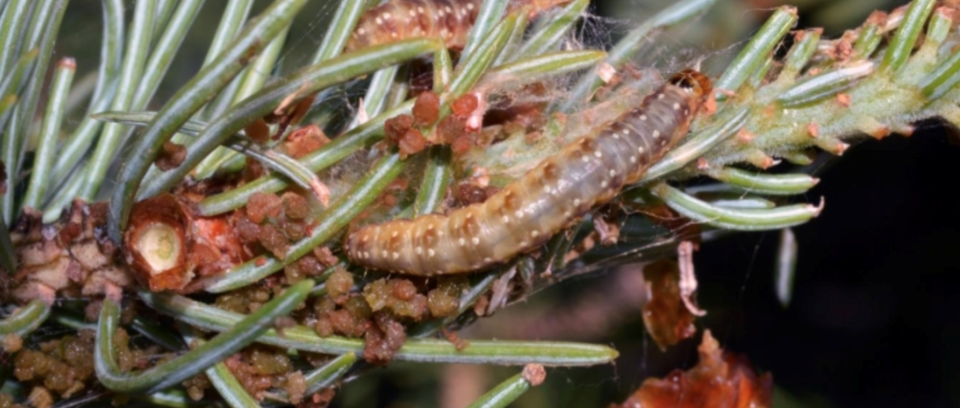Whistler residents and guests to the resort might have noticed an off-coloured tinge in the forests this week.
According to the Cheakamus Community Forest (CCF), an outbreak of western spruce budworm is to blame.
In a post on its website July 24, the CCF noted red trees are showing in the areas above White Gold, Function Junction and along Sproatt and Rainbow Mountains. The outbreak is reportedly happening across the Coast/Interior transition forests from Whistler to Hope, and seems to be restricted to the band of higher elevation forests (about 800 to 1,100 metres), the post said.
"At this point, the Cheakamus Community Forest (CCF) is monitoring the situation in connection with the Ministry of Forests (MOF) and taking a wait-and-see approach. If tree mortality begins to occur at an unacceptable rate over the next couple of years, the CCF will work with the MOF to determine next steps," the post said. "Currently, the only viable management option is to aerial spray with Bacillus thuringiensis var. kurstaki (Btk), a biological agent that kills the caterpillar when it eats the treated tree needles and is harmless to other species."
Bob Brett with the Whistler Naturalists said he is happy to see officials propose a wait-and-see approach, though he disputes that last point.
"It’s of course BS that such a chemical can target only one species, the most obvious proof being that the same one is used to kill other insect 'pests' including gypsy moths in Vancouver," Brett said in an email.
"I’m not keen on any non-specific chemical treatments since we already have a global crash in insect populations. Btk is designed to target lepidopterans, but the proponents don’t clarify that means it can potentially kill all moths (which include butterflies) and even other insects. A quick web search shows that even though it primarily affects insects, other invertebrates can be affected too ... That’s a big group!"
According to the CCF, the western spruce budworm is a native defoliator of interior Douglas-fir in British Columbia.
"It is not an introduced species. Outbreaks have been recorded in B.C. since the early 1900s to the present day," the CCF said on its website. "In 1987 and again in 2007-2008, over 800,000 hectares were infested by the budworm, mostly in the Southern Interior of the province. Budworm outbreaks may be sustained for years.
"The western spruce budworm feeds primarily on Douglas-fir. True firs, larch and spruce may also be affected. The caterpillars feed on the new needles, but will move onto the older needles if all new foliage is consumed. Trees appear reddish in colour once needles have been fed upon. Attack does slow down growth and can affect tree form."
Read more with this spruce budworm fact sheet.
Asked how the outbreak might increase wildfire risk in Whistler, CCF general manager Heather Beresford said it depends how long it lasts.
If it subsides in one or two years, fire risk likely won't increase substantially, but if it lasts longer than that and trees begin to die en masse, Whistler could be in trouble.
"The CCF will continue to monitor the situation. Typically, the Province will take the lead on a broad aerial spraying program and the CCF would participate if that became necessary," Beresford said in an email.
"If widespread mortality occurs on the [spruce budworm] stands, the risk of ignition within these stands is probably increased due to the more flammable nature of dead/dry stems on the landscape, and should a fire start in these dead stands it would likely move swiftly into adjacent live stand areas. The dead and weakened trees are also more susceptible to secondary pests (bark beetles, etc) which could contribute to the problem of dead trees on the landscape," she said.
"The bigger risk from fire across the whole Whistler Valley is the current stand conditions and abundance of dense/overdense stands. The whole valley is susceptible to landscape-level fire which could move swiftly through the crowns and into neighbourhoods. Similar to Jasper, the Whistler Valley has overly dense stands with 100-per-cent crown closure, limited landscape-level fuel breaks with housing integrated directly into the forests with no clear lines/divisions between urban and forested lands."
The complete devastation in Jasper is no doubt on the minds of all Whistlerites. In 2018, Jasper had a red-tree problem of its own, thanks to a mountain pine beetle infestation.
Beresford noted in Whistler, the focus is on a "tactical approach" to wildfire mitigation.
"The CCF is looking at the risk based on stand conditions, locations, modelled fire and climate information as well as the risk factors and starting the process of fireproofing/increasing the resilience of the landscape to fire," she said. "This looks like large-scale strategic fuel breaks that can be used to defend/hold a fire from spreading. This includes ensuring creation of fuel-break planning includes access planning for all parts of the community forest so that protection crews can easily access areas on the ground to set up defence lines to hold/stop a fire from advancing. Beyond the landscape-level fuel breaks there is also a need to plan/implement appropriate stand-level treatments, which are designed to decrease fire intensity and behaviour."
But the CCF can only do such work on Crown lands, not private, Beresford added.
"For individual homeowners, it means getting your property fully FireSmarted, not just cutting down a few trees around your house," she said. "Install metal roofing, close up gaps, and remove flammables around your house. In the bigger picture, entire streets and neighbourhoods need to do this instead of just individual houses here and there. The FireSmart program needs to be strategic and widespread."
Pique also reached out to the Resort Municipality of Whistler on the matter. Check back for more as this story develops...




